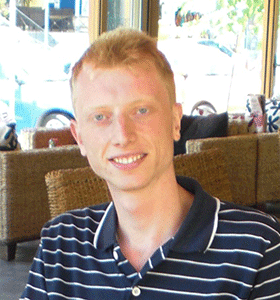Anders Sejr Hansen
To survive, cells must monitor their environments and elicit appropriate and timely responses to external stresses such as nutrient deprivation. In general, cells achieve this through signaling pathways: an external stress is sensed and information about the stress identity and intensity is transmitted downstream to proteins called transcription factors (TFs), which initiate changes in gene expression such as the expression of appropriate stress response genes. However, what is surprising is that many signaling pathways are bowtie-shaped (Figure 1): multiple different stresses converge on a single TF, which nonetheless induces multiple distinct and specific gene expression outputs.
It turns out that much like in radio broadcasting where AM and FM are alternative ways of transmitting information from different radio channels through the same airspace, cells also use AM and FM to transmit information about different stresses through the same TF. In the case of the budding yeast TF, Msn2, information about glucose deprivation is transmitted through FM, whereas information about oxidative stress is transmitted through AM (Figure 1).
Anders Sejr Hansen and Erin O’Shea wondered how much information cells can transmit through AM and FM – in other words, with what precision can cells tune pathways output (gene expression) to external stress intensity. To rigorously quantify this they turned to information theory, a mathematical framework originally developed for telecommunication. As anyone who has ever played a game of “Broken Telephone” will know, a pathway can only transmit as much information as its weakest link. They therefore focused on the gene expression step, which is known to be noisy and quantified information loss from TF input to gene expression output.
To control the amplitude and frequency of Msn2 activation, they combined high-throughput microfluidics, which enables the rapid delivery and removal of an Msn2-activiting small molecule, with quantitative time-lapse microscopy, which enables the measurement of fluorescent gene expression output. Surprisingly, they found that the information transduction capacity of individual genes is highly limited and not much higher than 1 bit. Phrased differently, cells can reliably distinguish no stress from high stress, but they appear unable to fine-tune stress gene expression to stress intensity. Furthermore, they showed that the information transduction capacity of genes can be tuned in cis : modulating the number and location of Msn2 binding sites in the promoter can increase information transduction. Nonetheless, they found that precise information transduction requires integration of information from multiple genes in a single cell and/or from a single gene in multiple cells. Finally, unlike in radio broadcasting where FM is generally preferred to AM since there is less noise, all the genes examined in this study showed higher information transduction under AM than FM. Overall, this study provides insight into how cells transmit information by regulating signaling dynamics and quantifies the limits on AM- and FM- mediated information transduction in cells.
Figure 1
Read more in eLife or down load PDF
This research was supported by the Howard Hughes Medical Institute (Erin O’Shea).


